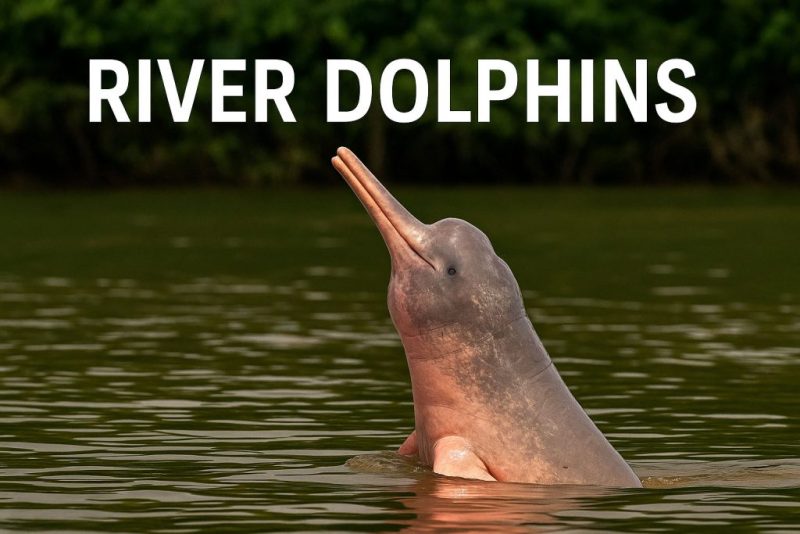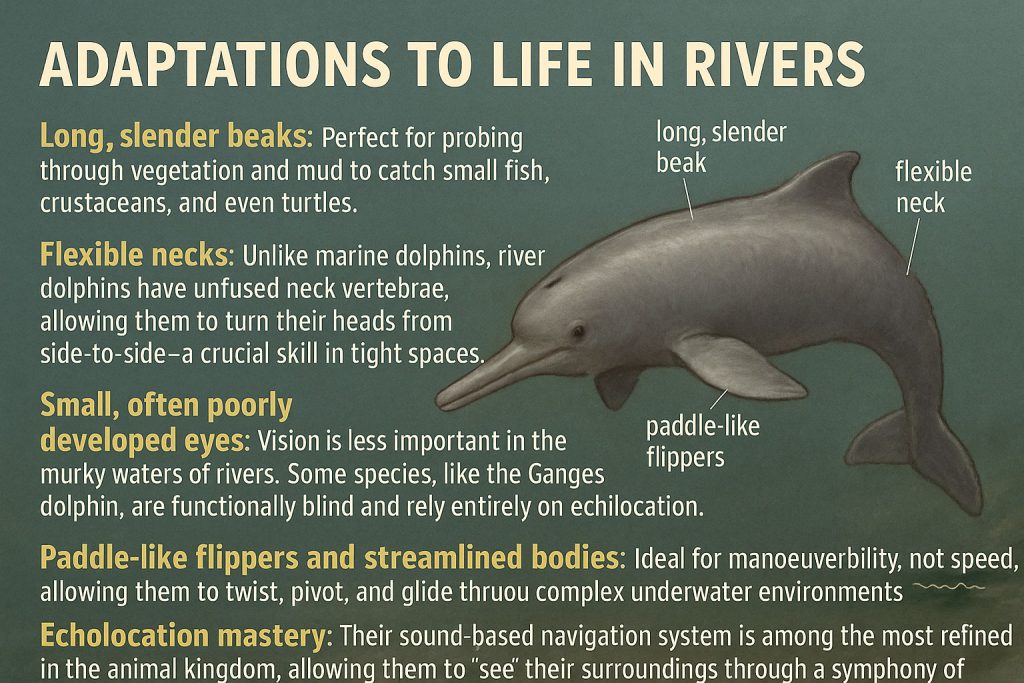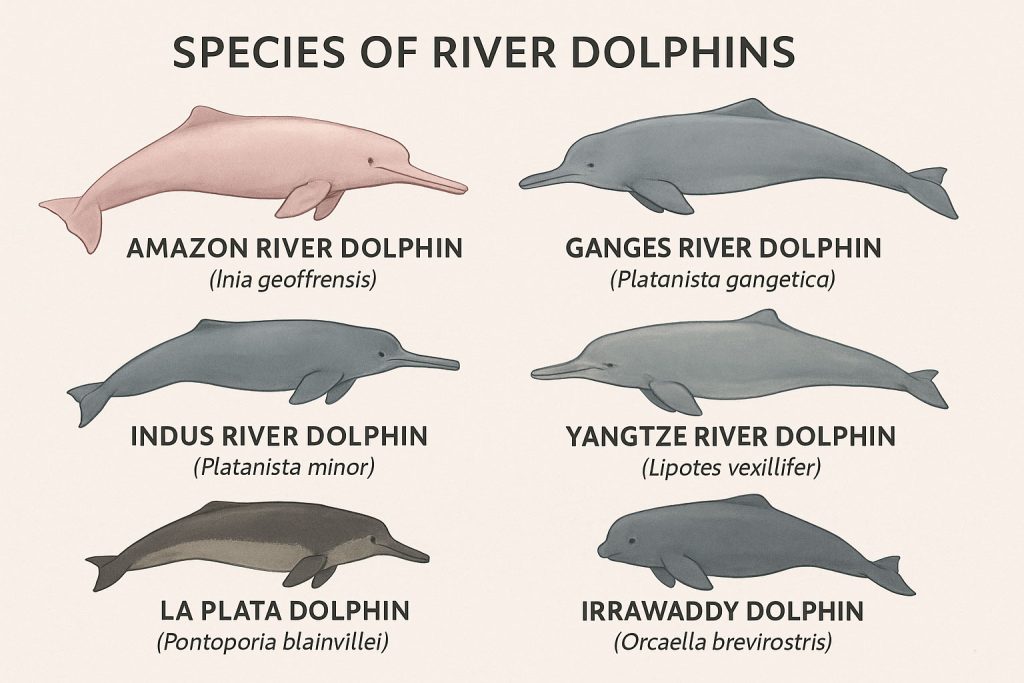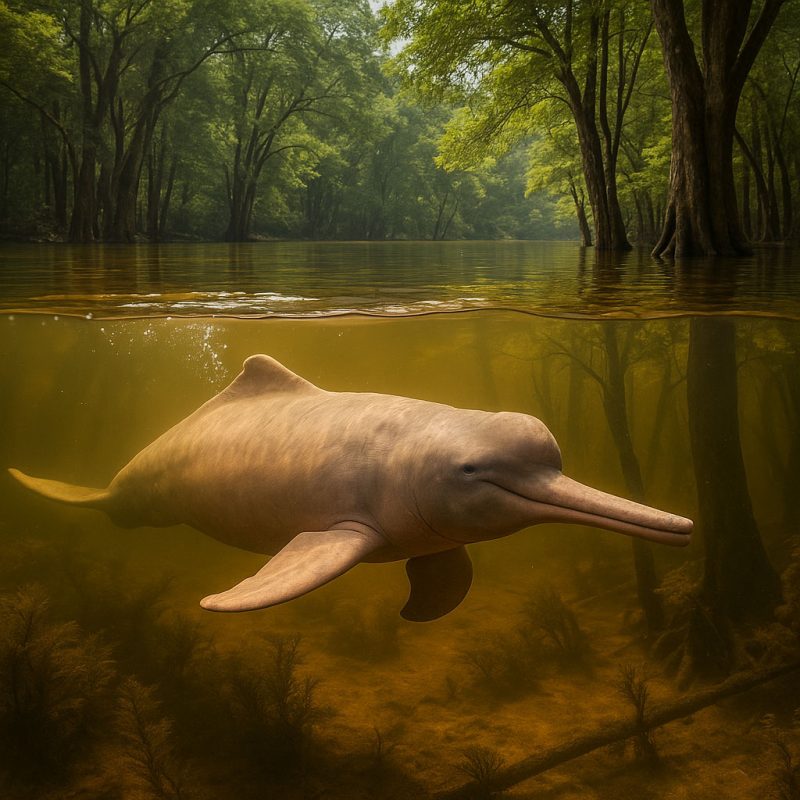🐬 River Dolphins – Mystical Swimmers of the Freshwater World

Discover the mysterious world of river dolphins—from the Amazon to the Ganges. Learn about their behavior, threats, and where to see them in the wild.
In the murky arteries of the Amazon, Ganges, and Mekong, a strange silhouette glides through the brown-green current—half-myth, half-mammal. With long beaks, gentle eyes, and flexible necks, river dolphins are unlike anything else in the aquatic world. They are among the most elusive and enchanting creatures on Earth, and their story is one of survival, adaptation, and quiet mystery.
Freshwater Royalty: Who Are the River Dolphins?
Unlike their oceanic cousins who roam the open seas in coordinated pods, river dolphins have evolved to survive in a vastly different world—one of narrow channels, swirling sediments, submerged forests, and ever-shifting currents. These ancient mammals represent a remarkable evolutionary branch, perfectly adapted to some of the most dynamic and challenging aquatic environments on Earth.
Adaptations to Life in Rivers
Life in freshwater is no small feat. River dolphins have undergone fascinating transformations to flourish in these complex systems:
- Long, slender beaks: Perfect for probing through vegetation and mud to catch small fish, crustaceans, and even turtles.
- Flexible necks: Unlike marine dolphins, river dolphins have unfused neck vertebrae, allowing them to turn their heads from side to side—a crucial skill in tight spaces.
- Small, often poorly developed eyes: Vision is less important in the murky waters of rivers. Some species, like the Ganges dolphin, are functionally blind and rely entirely on echolocation.
- Paddle-like flippers and streamlined bodies: Ideal for maneuverability, not speed, allowing them to twist, pivot, and glide through complex underwater environments.
- Echolocation mastery: Their sound-based navigation system is among the most refined in the animal kingdom, allowing them to “see” their surroundings through a symphony of clicks and echoes.
These adaptations make them ghosts of the river—graceful, elusive, and surprisingly agile in even the tightest corners of the floodplains.

🐬 Meet the Species: River Dolphins Around the World
Though united by freshwater habitats and similar features, river dolphins belong to different families and have evolved independently in separate parts of the world. Here are the most iconic species:
🇧🇷 Amazon River Dolphin (Inia geoffrensis)
Also called the boto, this dolphin is famous for its enchanting pink color, which becomes more vibrant with age or excitement. It inhabits the Amazon and Orinoco river basins, often seen during seasonal floods when the rainforest becomes an inland sea. Highly intelligent and curious, the boto is steeped in local folklore—believed to transform into a man at night to seduce women.
🇮🇳 Ganges River Dolphin (Platanista gangetica)
India’s national aquatic animal, the Ganges dolphin, also known as susu, is revered as sacred and linked to Ganga Ma, the goddess of the river. It is nearly blind, navigating exclusively by echolocation. It inhabits both the Ganges and Brahmaputra river systems and is critically endangered due to pollution, dams, and habitat fragmentation.
🇵🇰 Indus River Dolphin (Platanista minor)
Once considered a subspecies of the Ganges dolphin, the Indus dolphin now stands as its own species. Found mainly in Pakistan’s lower Indus River, it faces similar threats but has shown hopeful signs of recovery in protected areas. Locally called bhulan, it is adapted to low-visibility waters and spends much of its time swimming on its side.

🇨🇳 Yangtze River Dolphin (Lipotes vexillifer)
The baiji, or “Goddess of the Yangtze,” is a tragic symbol of lost biodiversity. Declared functionally extinct in the early 2000s, it was a victim of rapid industrialization, boat traffic, and dam construction. The baiji’s decline marked the first extinction of a cetacean species due to human activity in modern times.
🇦🇷 La Plata Dolphin (Pontoporia blainvillei)
Also known as the Franciscana, this species lives in estuarine and coastal waters of the La Plata River region in Argentina, Uruguay, and Brazil. Although not strictly a river dolphin, it shares many of their traits and is often grouped with them. Its small size and vulnerability to fishing nets make it one of the most threatened cetaceans in the South Atlantic.
🇲🇲 Irrawaddy Dolphin (Orcaella brevirostris)
Found in coastal, brackish, and freshwater habitats across Southeast Asia, especially in the Irrawaddy, Mekong, and Mahakam Rivers, this dolphin has a bulbous forehead and no beak, giving it a unique appearance. Social and shy, it is often seen surfacing quietly in groups. These dolphins are critically endangered in river systems due to entanglement in fishing gear, habitat degradation, and dam construction.
🌿 Adapted for a Hidden World
River dolphins are not built for speed. They’re flexible, with paddle-like flippers and long snouts perfect for hunting fish in flooded forests, narrow channels, and shallow backwaters. Their eyesight is poor—sometimes nonexistent, as in the blind Ganges dolphin—but their echolocation is exceptional, allowing them to “see” through sound.
Their pink or gray skin helps them camouflage in turbid water, and their social behaviors range from shy and solitary (like the baiji) to playful and curious (like the boto, which has even been observed playing with turtles and branches).

🐬 Cultural Legends and Local Lore
In many parts of the world, river dolphins are more than animals—they are spirits, omens, or shapeshifters. The Amazonian boto, in particular, is wrapped in myth. Locals say it transforms into a handsome man at night, seducing women during river festivals. In South Asia, Ganges dolphins are seen as sacred, representing purity and resilience.
⚠️ On the Brink: Threats and Conservation
Sadly, these magical creatures are among the most endangered mammals on Earth.
- Dams and water diversion fragment their habitats and block migration routes.
- Pollution, especially from mercury and plastics, poisons their food sources.
- Fishing gear and boat strikes lead to frequent injuries and death.
- Noise pollution interferes with their delicate echolocation.
The baiji of the Yangtze River may already be functionally extinct—a haunting symbol of what happens when industrialization outpaces protection.

But all is not lost.
Conservation efforts are gaining traction. In India, protected sanctuaries like Vikramshila Gangetic Dolphin Sanctuary offer safe havens. In the Amazon, researchers and Indigenous communities are working together to monitor and protect the boto. And around the world, river dolphin populations are becoming ambassadors for clean water and river conservation.
🌏 Why River Dolphins Matter
River dolphins are more than adorable oddities. They’re keystone species, indicators of river health. If dolphins disappear, it’s a warning that the ecosystem is collapsing.
Saving them means saving the rivers themselves—the lifeblood of forests, farms, and entire civilizations.
📷 Spotting River Dolphins in the Wild
Here are a few places where you might (respectfully and responsibly) see river dolphins:
- Amazon Rainforest – near Manaus, Brazil or Iquitos, Peru
- Ganges and Brahmaputra Rivers – boat safaris in India or Bangladesh
- Indus River – in Sindh province, Pakistan
- Mekong River – rare sightings near Kratie, Cambodia
Always choose ethical operators who follow dolphin-safe practices and maintain distance. River dolphins are shy by nature—and they deserve peace.
🌀 Final Thought:
River dolphins are gentle messengers from a world we’re still learning to understand—a world of flooded forests, forgotten backwaters, and the soft sonar clicks of a freshwater symphony. Protecting them is not just about saving a species. It’s about safeguarding the soul of our rivers.



